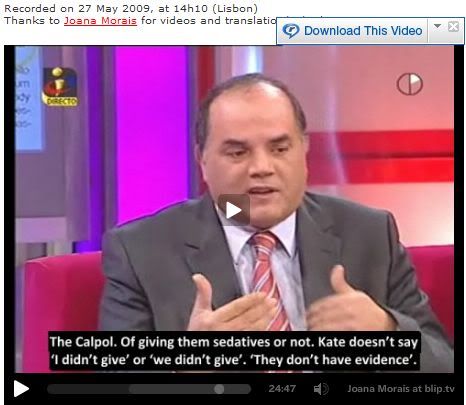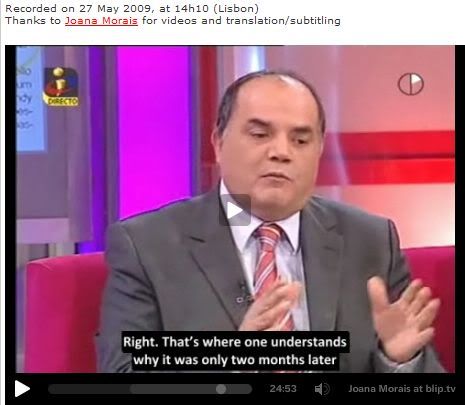NVC analysis of McCann sedative interview
Sedative Interview
Interviewer question
“On that evening did you give to your kids something like calpol to help them sleep?”
Gerry McCann -
“(swallow, els&dr)(Intake of breath) you know we’re not gonna (head back) comment, on anything (ec) but you know there is absolutely (head back). No way we use any sedative drugs (head down, ec, head shake, scratch behind l earlobe, looks back at I, slight smile) or anything like that en (ldr, rhb) you know we’ll we have (ldr) co-operated with the police (ldr) we’ll answer any queries ermm (ldr)…any tests that they want to do en.”
First cluster – Swallow, eyes look sideways & down right, intake of breath
Firstly, the Adam’s apple is emotionally responsive (i.e. it reflects visceral or gut feelings). Acting through the vagus nerve (cranial X) emotional tension from the brain’s limbic system causes unconscious muscular contractions of the sternothyroid, thyrohyoid and associated inferior pharyngeal constrictor muscles of the Adam’s apple. This movement is evident as the muscles contract to swallow, to throat-clear or to vocalize an objection that may be left unsaid. This swallowing movement indicates feelings of anxiety or embarrassment.
I find it hard to imagine why Gerry would become anxious or embarrassed by this question (angry, hurt, yes), unless of course these feeling were stimulated at the prospect of having to lie in which case it would indicate that either he, or someone else, had given the children calpol or other sedatives to help them sleep on that night.
Secondly, eye movements are largely controlled by the midbrains Oculomotor, Trochlear and Abducens nerves (cranial III, IV & VI). According to neurological research, eye movement both laterally and vertically seems to be associated with activating different parts of the brain. Generally, when eyes look right it is indicative of the brain working at constructing, up right eye movements indicate construction of visual images, sideways right eye movements indicates construction of audio. When eyes look left it is indicative of the brain recalling or accessing memory. Up left eye movements, indicate recalling of visual images, sideways left eye movements indicate recalling of audio. When eyes look down left it indicates internal dialogue and down right indicates that a person is thinking about the question as they recall smell, feelings or taste.
In the video clip, we see Gerry look sideways right and down right. He looks sideways right first. This indicates that he might be constructing something auditory. This might include for example constructing what he will say or could say to the question., or he may be assembling the question in his mind due to the fact that he has not heard it before. We also see this movement directly followed by a right down eye movement. This motion indicates that Gerry is thinking about the question and his feelings. I am uncertain as to whether officials, or anyone else to that matter, had asked Gerry about the use of sedatives before this interview took place; hence, suggestions of Gerry constructing a lie must be posited with caution.
Still, the answer to the question should be easy, either a yes or no. Moreover, when taking into account the media coverage of the sedative use issue I would think that the answer should be well known to Gerry McCann, surely someone must have alerted him to the “ludicrous” suggestions being made in the media!; thus, the answer should be in his near term memory, this would not require him to search for an answer (in this case eye movements would be barely be visible).
Thirdly, the intake of breath that we hear Gerry making may be nothing more than pre-speech in-breath. Interestingly though, the pre-speech in-breath is often used by an array of professionals to add an air of authority and credibility to the qualifying subsequent spoken words. It is also a typical expression of ordinary conscious anxiety and tensions reflected in other kinesic behaviours including the aforesaid.
From this cluster I think it would be fair to say that the question “On that evening did you give to your kids something like calpol to help them sleep?” aroused emotion, albeit anxiety, embarrassment or stress, or a combination of the three. If Gerry did not administer calpol or sedatives to the children that evening (or knows with certainty that no one else had) then I see no reason for the arousal of emotions witnessed.
Second Cluster- Head down, eyes closed, head shake, scratch left ear lobe, looks back at Interviewer but does not raise head, slight smile, look down right, left hand brush away from body.Observed during “No way we use any sedative drugs”The head down motion is an automatic escape movement designed to remove a body part or parts from danger. It underlies many negative and submissive nonverbal signs (e.g., feelings of guilt or shame or cues of fear or submissiveness). It is suggested that bending motions of the head (and trunk) are neurologically “simple” as NVC signs. As they are unaffected, unintended, and unconscious; thus, they are among the most reliable indicators of mood. Gerry’s eyes also gaze down in conjunction with the head down motion. Gaze-down often reflects guilt, shame, submissiveness or deception. These feelings pass from the limbic system and basal ganglia to the midbrain’s oculomotor (cranial III) and other cranial nerves. Acting in concert, the eye muscles pull together in a downward or sideward eye movement, depending on the mood.Gerry’s words “No way we use any sedative drugs” appear to arouse feelings of guilt, shame and/or deception. (Note – I rule submissiveness out firstly, as Gerry’s baseline demeanour does not suggest that he is submissive; secondly, as a result of my findings in the first cluster; thirdly, he hardly submits to answering the question does he?) If he is feeling guilty or shameful then the question “what about?” must be asked. If he is telling the truth, then he has no reason to feel ashamed or guilty; the answer is simple, he is lying. However, how big is the lie? Look at the question again, “On that evening did you give to your kids something like calpol to help them sleep?” We should note that he does not anywhere in his answer state that they did not give the children sedative drugs that night, nor does he deny the use of calpol. In fact, what he says is “there is absolutely no way we use any sedative drugs or anything like that”!Gerry also closes his eyes when he uses the head and eye down motion. When this cue is used during or shortly after a verbal denial, it usually shows that the speaker does not believe his or her own remarks. As true statements are normally given with a confident, face to face or level gaze, which might be held for longer than three seconds. In addition, Gerry also shakes his head in conjunction with the aforementioned NVC signs. Interestingly, the headshake is associated with cognitive dissonance and this is where feelings of uncomfortable tension arise because of holding two conflicting thoughts in the mind at the same time. It should be noted that dissonance is often strong when we believe something about ourselves and then do something against that belief. The headshake is also linked to uncertainty and is gut reactive; thus, this motion originates from the limbic system, which stimulates the special visceral accessory nerve (cranial XL).The scratching of the ear lobe is a self-touch cue aimed at relieving stress and/or providing comfort. It reflects arousal of the SNS’s flight or fight response. Ear lobe (and nose) scratching results from blood vessel engorgement whilst in this state; thus, this cue is indicative of increased anxiety and may signal deception, disagreement, fear or uncertainty.
We also see Gerry glance back at the interviewer without raising his head; this method is often used in the act of deception to gauge the response of those being addressed. (I.e. it is used to see if the listener is swallowing the lie.)
Gerry also appears to produce a slight smirk, almost a look of amusement. In NVC, smirking is a sign of contempt for the gullibility of the person(s) who are being duped. Smirking is also indicative of someone having something further to share. For example, when Susan Smith stated that wherever her children were she hoped they were ok, she smirked then smiled…she knew where they were and what state they were in; she knew they were dead – she had something further to share.
Gerry raises his left hand and makes a tight brush away motion from the body at neck height. What is interesting is that this motion signifies the brushing away or dismissing of a subject or the spoken words in the event of deception. Furthermore, the tighter the hand or arm movement is to the body the more indicative it is of deception. It should be also be noted that we do not ordinarily make conscious choices about the hand or arm gestures as we are usually too busy talking to notice or care.
This cluster is certainly indicative of deception as Gerry exhibits a combination of deceptive signals that are in agreement with each other: I cannot find one NVC signal that could cast significant doubt on this assertion.
My conclusion is that Gerry McCann fails to answer the question, choosing instead to skirt around the question in a somewhat defensive manner: Gerry McCann is engaging in the act of deception.
Question
“On that evening did you give to your kids something like calpol to help them sleep?”
Truthful answer
“No I (we) did not” or “Yes I (we) did”
Note – when we are truthful about something we tend to be direct and confident in our spoken word, our NVC mirrors this.
Yet Gerry McCann answers
“You know we’re not gonna comment on anything but you know there is absolutely . No way we use any sedative drugs or anything like that en you know we’ll we have co-operated with the police we’ll answer any queries ermm …any tests that they want to do en…”
I thought it might be interesting for readers to compare the above analysis with a LVA 6.50 analysis of the sedative interview.

















